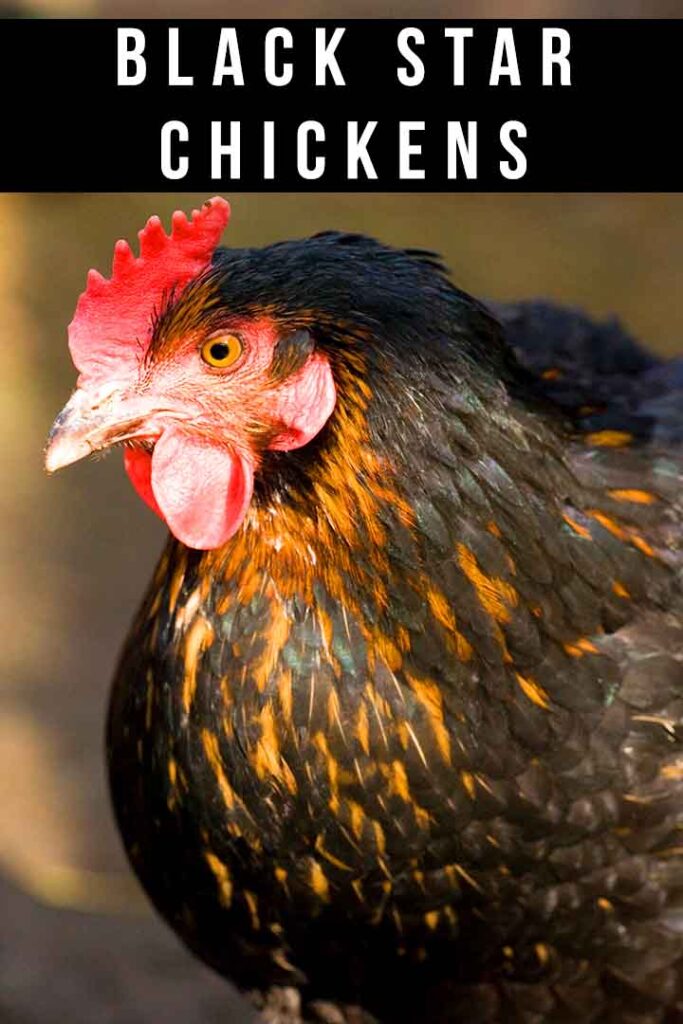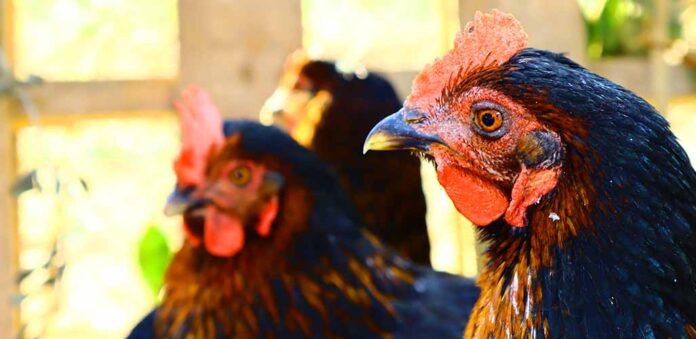Black Star chickens are the hybrid offspring of a Rhode Island Red rooster, and a Barred Plymouth Rock hen. They gained popularity for being prolific egg layers, and because female chicks can be easily distinguished from male chicks, immediately from hatching. This complete guide to Black Star chickens covers all aspects of raising a Black Star hens, including their main advantages, disadvantages, and peculiarities.
Contents
- What is a Black Star chicken?
- Black Star chickens’ appearance
- Black Star chicken temperament
- When do Black Star chickens start laying eggs?
- How many eggs do Black Star chickens lay?
- How long do Black Star chickens live?
- Black Star chicken care
- Are Black Star chickens cold hardy?
- Are Black Star chickens heat tolerant?
- Alternatives to the to the Black Star chicken breed
- Are Black Star chickens right for me?
In this video you can easily see the white dot on the head of male chicks.
What is a Black Star chicken?
Black Star chickens are the celebrity mixed breed of the poultry world – the chicken equivalent of a Labradoodle in terms of how quickly they rose to fame, and how popular they are to keep. Black Star chicks are the product of a Rhode Island Red rooster fertilizing eggs laid by a Barred Plymouth Rock hen. The egg industry happened upon this cross shortly after the end of WW2, when demand for affordable, efficient food production was at an all time high. Lots of different chicken hybrids were attempted, and the Black Star hens stood out for their exceptional number of eggs they laid. Best of all, female chicks could be immediately distinguished from males by their plumage, which was quicker, easier and more reliable than any alternative method for sexing chicks available at the time. We’ll cover what that tell-tale difference in plumage is, in the next section.
Black Star chickens appearance
Black Stars are a medium sized chicken breed: a Black Star hen grows to about 5lbs, and a Black Star rooster grows to about 7 or 8lbs. They have orange eyes and a single red comb on their head. When they hatch the chicks are easy to tell apart because females (also known as pullets) are entirely black, but male chicks are black with a spot of white on top of their head. Owing to this handy difference between male and female chicks, they are also known as a black sexlink chicken.

When they grow up, females have mostly black plumage with some coppery gold feathers on their breast, and their beak has black and yellow stripes. Mature males are taller and leaner, but heavier, than females. And all of their feathers have bars of black and white on them, creating a stripy salt’n’pepper appearance.
Black Star chicken temperament
Black Star chickens initially became popular because females were easy to identify after hatching, and reliably produced large quantities of eggs. These days, Leghorn chickens are more popular with commercial egg producers, because they lay even more eggs, and their shells are white. But, Black Star chickens have remained popular with homesteaders and backyard chicken keepers, thanks to their sweet and placid personality. Black Stars are usually described as docile, tolerant of being petted by children, and cuddly if handled from a young age. They are easy to tame, and will go out of their way to be friendly and sociable with humans. Importantly for lots of people, they are usually quiet except to tell you when they have laid an egg. In short, there’s little about them to offend their owner, or their owner’s neighbors!
Like all chickens, they prefer living in a group, and will spend some of their time establishing a pecking order. Provided they’re healthy and their enclosure meets their needs, you’ll also spot them preening, perching, dust bathing, and showing alert interest in their surroundings. Many people are surprised to discover that chickens all have their own unique personality, and watching them go about their business can easily swallow hours of your day!
When do Black Star chickens start laying eggs?
Black Star chickens start laying eggs around 22 to 24 weeks old, a short time after reaching sexual maturity. This is called ‘coming into lay’. Sometimes a hen’s first few eggs are unevenly shaped. This is normal, and they are still perfectly safe to eat. Black Star chickens eggs are larger than average, and brown, due to a layer of pigment on the outside of the shell. The brown pigment doesn’t go all the way through the shell – the inside surface is white.
How many eggs do Black Star chickens lay?
An important advantage of Black Stars for lots of owners is their high egg-yield. These productive birds routinely lay over 250 eggs a year, and sometimes over 300! Which means just two or three birds are enough to keep most families in ready supply. Egg laying is controlled by hormone levels which change according to how many daylight hours there are per day. So egg laying naturally slows down or stops altogether in mid-winter, but some chicken keepers choose to overcome this using artificial lighting.
How long do Black Star chickens live?
Black Stars usually live for between 3 and 8 years. But, their phenomenal egg laying powers tend to decline from about 18 months onwards, and burn out completely between two and three years old. It’s an uncomfortable fact of keeping backyard hens that you may need to make some difficult decisions once a hen’s egg laying days are behind her. Keeping several birds in honorable retirement in addition to your actively laying birds might not be financially sensible. For some people, culling older hens who have stopped laying is the pragmatic decision. For others, letting a sweet natured old bird live out her days in peace is the least they can do as a thank you for all the eggs. When the time comes, you are free to make your own choice.
During their lifetime, potential health problems of Black Stars which you need to be alert for are:
- Obesity due to eating unsuitable food, or an excess of high-calorie treats.
- External parasites such as lice and mites.
- Internal parasites such as worms.
- Problems laying, including egg binding (when an egg gets stuck inside the hen) and egg yolk peritonitis (when material from the egg yoke finds its way into the body cavity, causing inflammation and potential infection).
- Sour crop (a fungal infection of the digestive tract).
- Cancers.
Always be vigilant for the following signs of illness in chickens, and take them to an appropriately experienced veterinarian if you spot any of them:
- Listlessness.
- Pale comb and wattles.
- Itchiness or restlessness.
- Reduced egg production.
- Weight loss.
- Matted feathers or bald patches – especially around their butt.
- Reluctance to enter their hen house.
Black Star chicken care
Black Stars are often described as one of the most hardy and easy to keep chicken breeds. But that doesn’t mean you can just pop a couple in your yard and watch them go. Before committing to chickens it’s important to research their husbandry thoroughly, and ideally find a more experienced mentor who can help you get set up and answer questions as they come up. Some of the essentials your chickens will need are:
- A suitable diet. Black stars need a balanced diet which is at least 16% protein. In the past, keeping chickens was a popular way of turning table scraps into egg, but in many regions that is now outlawed, in order to prevent disease transmission. Feed your Black Stars a balanced and complete chicken feed first thing in the morning – ideally they should have eaten 80% of their food for the day by noon, to allow time for egg laying later.
- Fresh water. Hens do have a habit of pooping in their water bowl, so change it frequently.
- A secure outdoor space to run, explore, stretch their wings. Over crowded conditions are more likely to lead to aggression between your hens. Enclosing their run protects your garden, protects them from predators, and prevents introduction of parasites by wild birds.
- A secure, elevated, and insulated roosting box. With a minimum of 1 square foot per bird, plenty of perches, and good ventilation but no drafts.
- Regular cleaning out. Replace the litter in their roosting box once a week, and thoroughly scrub and disinfect everything every few months.
- Soluble and insoluble grit. Soluble grit is critical for shell formation, and insoluble grit sits in chickens’ stomachs and helps break down their food.
Are Black Star chickens cold hardy?
Black Stars are ideal for people who live in colder areas. They are widely regarded as adaptable, low maintenance, and in poultry parlance ‘thrifty’. Which basically means they’re economical to keep, and don’t require more financial outlay than average setting up a suitable enclosure. To keep them in cold climates, make sure their nesting boxes are dry and well insulated. Since they’re likely to spend more time inside than if they lived in a milder climate, try to give them as much indoor space as possible (such as a shed big enough to move around in freely).
Are Black Star chickens heat tolerant?
Live somewhere hotter than average? That’s fine too. Luckily chickens love a dust bath! Make sure your birds have unlimited access to fresh water though, and access to shade whenever they want it.
Alternatives to the to the Black Star chicken breed
It’s hard to imagine a sweeter hen than a Black Rock, but if you’d like to find out about some other popular laying breeds, visit us at these pages:
- Rhode Island Red Chickens – Your Perfect Poultry?
- Chicken Breeds – Your Guide to the Best Pet Chickens
You might also enjoy the following resources:
- What Do Baby Chicks Eat? From Birth To The Laying Stage
- Can Chickens Swim?
- Chicken Names – 220 Adorable Ideas For Naming Perfect Poultry
- Can Chickens Eat Watermelon?
- Best Chicken Coop – Choosing The Best Home For Your Hens
Is a Black Star chickens right for me?
Black Star chickens are right for just about everyone who’s ready to make the commitment to keeping poultry. They are a good first breed for novice owners, as they are widely available, cheap to buy, and straightforward to keep. If you’d like an emotional bond with your hens, the sociable Black Star is a perfect choice. They are generally healthy and robust, but like all chickens bred to lay eggs in large quantities, owners need to be vigilant for signs of that process going wrong. Perhaps the only other drawback of the Black Star is that being a mixed breed, they don’t qualify for chicken shows. So if you’re interested into getting into the world of showing your birds competitively, you’ll be better off with a ‘pedigree’ breed.
Do you have Black Star chickens?
Do you have a Black Star chickens living in your back yard? We’d love to hear all about them in the comments below.
References
Colville-Hyde. Poultry husbandry: key management points. The Veterinary Nurse. 2013.
Davies. Chicken nutrition. The Veterinary Nurse. 2016.
Davies. Common poultry parasites of backyard hens. The Veterinary Nurse. 2016.















